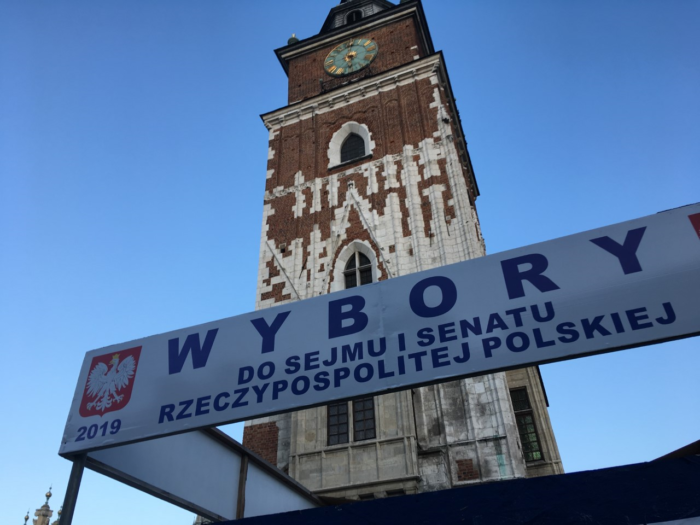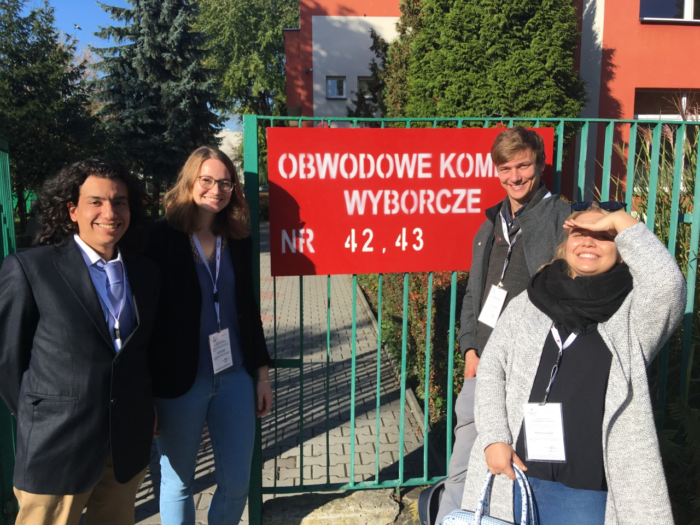Democracy up close: Experiencing Election Day in Poland
by Carolin Heilig, 18 October 2019

There are not many opportunities to experience democracy as directly as on election day. The opportunity to witness the 2019 parliamentary elections in Poland first-hand was an eye-opening experience. Thanks to the European Students’ Network, I was given the chance to join their international election observation mission to Poland.
As an independent, short-term election observer of the European Students’ Network (AEGEE), I experienced the whole election day in Krakow from the setting up of the polling station at 6:30am to the conclusion of the vote count at around 4:00am the next day. The AEGEE mission comprised 12 teams of international observers and local interpreters, covering 104 polling stations all over the country with a special focus on youth participation. The observation guidelines and standards we adopted have been developed by OSCE/ODHIR and the mission included meetings with stakeholders before election day. [See here the official AEGEE press release here.]
We often pay close attention to the outcomes of elections and the campaigns leading up to them. Spending the whole day in ten different polling stations last Sunday, however, really drew my attention to the election processes themselves and significantly increased my respect for the citizens that make these elections possible.
The parliamentary elections in Poland took place on Sunday 13 October from 7:00am until 9:00pm, which meant that the members of each electoral commission had to start setting up the polling station no later than 6:00am. Usually, each polling station has four election booths shielded by cardboard walls. The large, transparent ballot box sits in the centre of the room and the members of the commission sit opposite the election booths with the list of registered voters and the empty ballots.
The most interesting part of the observation was the opportunity to witness the behaviour of voters. After proving their identity, voters would receive two ballots (a large one for the Sejm and a smaller one for the Senate). Generally, voting seemed to be a family event, with many voters coming with their partners or with their children. The secrecy of the vote was not enforced when, for instance, spouses used the same voting booth to cast their votes, and the AEGEE observers witnessed instances of group voting in almost every polling station. Children often accompanied their parents inside the booth, and it was quite a common practice to let your child put your vote into the ballot box. It was a pleasant surprise to see how children could experience democratic elections and how proud many of them were “to participate”.
The role of the Church in Polish politics is controversial and it was interesting to see how the Sunday mass times influenced the peak hours of voting: In the morning, some polling stations witnessed a strong influx just after mass finished and there was another peak period in the afternoon. The last voters rushed into the polling stations just before 9:00pm, by which time the record turnout of the 2019 elections had already been established (61.7%). Only in 1989, during the semi-free, founding parliamentary elections of the Third Republic the turnout was higher (62.7%).

The counting of the votes was a tedious process and my polling station did not finish it until after 4am. During the process, the election commission was not allowed to leave the room and after more than 22 hours of being in the polling station, the exhaustion was clearly visible.
After 22 hours of observation, my team and I were worn out but my respect for the democratic process of elections increased significantly. At 61.7%, this was the highest turnout in truly free parliamentary elections since the fall of communism in 1989. All in all, I am grateful for the opportunity to have witnessed a Polish electorate mobilized to the highest level in the last three decades.
While the results of the previous elections in 2015 came to many observers as a surprise, this year’s elections solidified the majority of the ruling nationalist-conservative Law and Justice party, as was expected. How the election outcomes will impact the quality of the Polish democratic processes, the rule of law and the many contested policies, such as reproductive rights, remains to be seen. The Senate, the upper chamber, is now controlled by the opposition with a tiny majority. The elections also brought the entry of the radical-right wing party Confederation Liberty and Independence and the return of the Left to the Sejm. As we also saw with the Hungarian municipal elections, Poland proved that the monopoly of the ruling party in a system that preserves at least a modicum of democratic mechanisms is never set in stone.